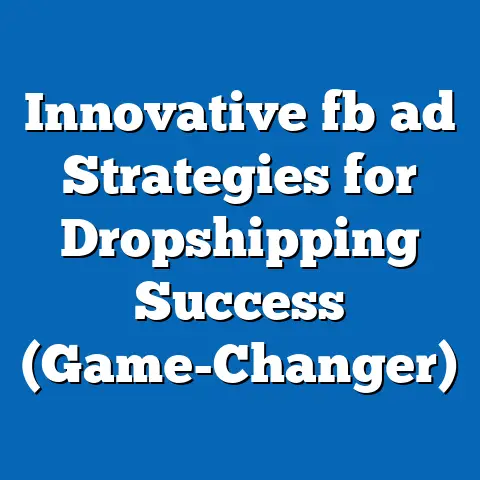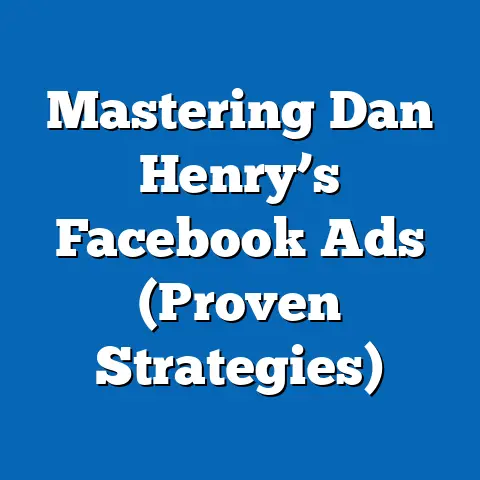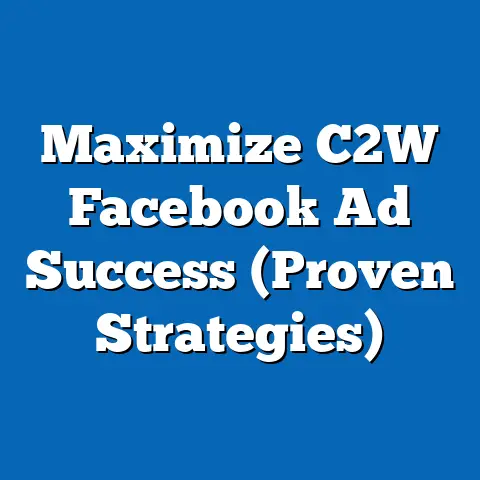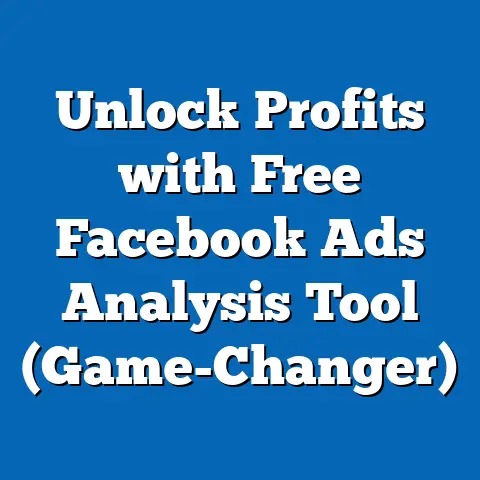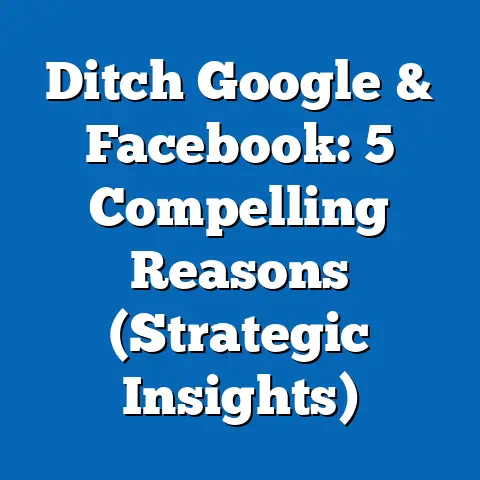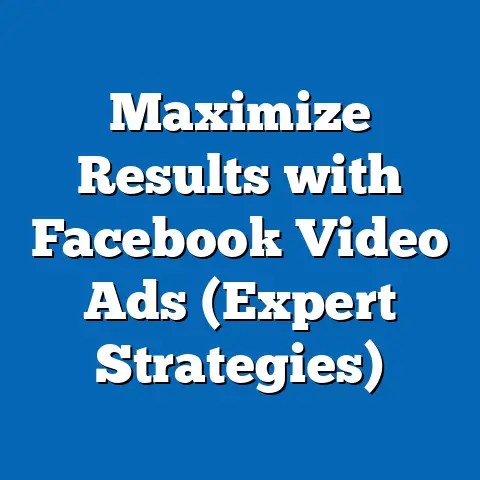Unlocking Product Ads on Facebook (Expert Strategies Unveiled)
Imagine a small e-commerce business owner, Sarah, who launches her handmade jewelry store online in 2023. After months of struggling with organic reach on social media, she turns to Facebook product ads to target her ideal audience—women aged 25-44 with an interest in fashion and accessories. Within weeks, her ad campaigns generate a 300% increase in website traffic and a 150% boost in sales, illustrating the transformative power of targeted advertising on the world’s largest social media platform.
Facebook, now under the Meta umbrella, remains a powerhouse for digital advertising, with over 2.9 billion monthly active users as of 2023, according to Statista. Product ads, specifically those integrated with the Facebook Marketplace and Shops, have become a critical tool for businesses, with ad revenue for Meta reaching $114.9 billion in 2022, a significant portion driven by e-commerce campaigns (Meta Annual Report, 2022). Demographically, users aged 25-34 make up 29.6% of the platform’s audience, while women account for 43.7% of global users, shaping the targeting strategies for product ads (DataReportal, 2023).
Historically, Facebook’s advertising ecosystem has evolved from basic banner ads in 2007 to sophisticated, AI-driven dynamic product ads by 2023, with click-through rates (CTR) for e-commerce ads increasing from 0.9% in 2015 to 1.6% in 2022 (WordStream, 2022). Looking ahead, projections suggest that Meta’s ad revenue will grow to $150 billion by 2025, fueled by advancements in augmented reality (AR) ad formats and deeper integration with Instagram Shopping (eMarketer, 2023). This article delves into expert strategies for unlocking the potential of Facebook product ads, supported by detailed data, demographic insights, historical trends, and future outlooks.
Detailed Analysis: The Power of Facebook Product Ads
Why Facebook Product Ads Matter in 2023
Facebook product ads, particularly through the platform’s dynamic ads and catalog sales features, allow businesses to showcase specific products to users based on their browsing history, interests, and behaviors. These ads are not static; they adapt in real-time, displaying relevant items from a business’s product catalog. This personalization is a game-changer, with studies showing that dynamic ads achieve 2.5 times higher conversion rates compared to standard image ads (Meta for Business, 2023).
In 2023, e-commerce businesses allocate approximately 23% of their digital ad budgets to Facebook, second only to Google Ads at 28% (eMarketer, 2023). The platform’s ability to integrate with tools like Shopify and WooCommerce further streamlines the ad creation process, enabling businesses to upload product catalogs with ease. Moreover, the average return on ad spend (ROAS) for Facebook product ads in the retail sector stands at 6:1, meaning for every $1 spent, businesses earn $6 in revenue (WordStream, 2023).
The effectiveness of these ads is also tied to Facebook’s vast user base and granular targeting options. Businesses can target users by age, gender, location, interests, and even life events like engagements or new parenthood. This precision ensures that ads reach the most relevant audiences, maximizing impact and minimizing wasted spend.
Key Metrics Driving Success
To understand the impact of Facebook product ads, let’s explore key performance indicators (KPIs). The average cost-per-click (CPC) for e-commerce ads on Facebook is $0.97, significantly lower than Google Ads’ $2.69 (WordStream, 2023). Meanwhile, the average conversion rate for product ads hovers at 9.2%, compared to 3.8% for traditional display ads (Meta for Business, 2023).
Engagement metrics also highlight the platform’s strength. Product ads with video content see 48% higher engagement rates than static images, while carousel ads, which showcase multiple products, achieve a 30-50% lower cost-per-conversion (Hootsuite, 2023). These figures underscore the importance of creative strategy in maximizing ad performance.
Beyond metrics, user behavior plays a critical role. Approximately 78% of Facebook users report discovering new products through the platform, and 54% have made a purchase directly after seeing an ad (Sprout Social, 2023). This “discovery-to-purchase” funnel is a key driver of product ad success, particularly for small and medium-sized enterprises (SMEs) like Sarah’s jewelry store.
Statistical Comparisons Across Demographics
Age-Based Targeting and Engagement
Facebook’s user base spans a wide age range, but certain demographics dominate engagement with product ads. Users aged 25-34 are the most active, accounting for 29.6% of the global audience and driving 35% of e-commerce ad clicks (DataReportal, 2023). This group is often in a life stage of career growth and discretionary spending, making them prime targets for products like fashion, tech gadgets, and home decor.
In contrast, users aged 18-24, while tech-savvy, contribute only 18% of ad clicks despite representing 23.1% of the user base. Their lower purchasing power and preference for platforms like TikTok for discovery may explain this gap (Pew Research, 2023). Meanwhile, the 35-44 age group, representing 21.4% of users, shows a high conversion rate of 11.3%, likely due to greater financial stability and family-oriented purchasing decisions.
Older demographics, such as those aged 45-54 (12.6% of users), engage less with product ads, contributing just 9% of clicks. However, when they do convert, their average order value (AOV) is 25% higher than younger groups, reflecting a focus on quality over quantity (Meta for Business, 2023).
Gender Dynamics in Ad Response
Gender also shapes how users interact with product ads on Facebook. Women, who make up 43.7% of the global user base, are 20% more likely to click on product ads than men, particularly in categories like beauty, fashion, and home goods (DataReportal, 2023). Men, comprising 56.3% of users, show stronger engagement with tech, automotive, and fitness products, with a conversion rate of 8.9% compared to women’s 9.5%.
Interestingly, women’s AOV is slightly lower at $45 compared to men’s $52, but their frequency of purchases is 15% higher, making them a critical demographic for repeat sales (WordStream, 2023). Businesses like Sarah’s, targeting female audiences, can leverage these insights by focusing on emotionally resonant ad copy and visuals that highlight product benefits.
Geographic and Socioeconomic Variations
Geographic targeting reveals stark differences in ad performance. In North America, where 10% of Facebook’s user base resides, the CPC is highest at $1.23, but the conversion rate is also strong at 10.7% (Meta for Business, 2023). In contrast, regions like South Asia, with 25% of the user base, have a lower CPC of $0.41 but a conversion rate of just 5.2%, reflecting economic disparities and differing online shopping habits.
Socioeconomic factors further influence outcomes. Users in high-income brackets (top 20% of earners) have a 30% higher AOV, while those in lower-income brackets (bottom 40%) are more responsive to discount-driven ads, with 60% citing price as the primary purchase driver (Pew Research, 2023). These variations highlight the need for tailored strategies based on location and income levels.
Historical Trend Analysis: Evolution of Facebook Product Ads
From Static to Dynamic: 2007-2015
When Facebook introduced advertising in 2007, options were limited to basic sidebar ads with minimal targeting capabilities. Engagement was low, with CTRs averaging 0.1%, as users viewed ads as intrusive rather than relevant (eMarketer, 2010). By 2012, the introduction of Sponsored Stories and early product ads shifted the focus to native formats, increasing CTRs to 0.6% (WordStream, 2012).
The real transformation came in 2014 with the launch of dynamic product ads (DPAs), which allowed businesses to retarget users with specific products they had viewed online. This innovation boosted conversion rates by 150% compared to static ads, marking a turning point for e-commerce advertising (Meta for Business, 2015). By 2015, Facebook’s ad revenue had grown to $17 billion, driven largely by early adopters of DPAs in retail and fashion sectors.
The Rise of AI and Integration: 2016-2020
Between 2016 and 2020, Facebook doubled down on AI to refine ad targeting and delivery. The introduction of the Advantage+ Shopping Campaigns in 2020 automated ad optimization, reducing manual effort for businesses while improving ROAS by 20% on average (Meta for Business, 2021). During this period, mobile ad impressions surged, with 94% of ad revenue coming from mobile devices by 2020, up from 69% in 2016 (Statista, 2021).
The COVID-19 pandemic in 2020 further accelerated reliance on digital ads, as physical stores shuttered and online shopping soared. E-commerce ad spend on Facebook grew by 44% year-over-year, with product ads accounting for 60% of campaigns in the retail sector (eMarketer, 2020). This period also saw the integration of Facebook Shops, allowing users to browse and buy directly within the app, shortening the purchase journey.
Modern Era: 2021-2023
By 2023, Facebook product ads have become a cornerstone of digital marketing, with Meta reporting that 80% of advertisers use dynamic ads as their primary format (Meta Annual Report, 2022). The platform’s focus on privacy, following Apple’s iOS 14.5 tracking changes in 2021, initially reduced ad effectiveness, with a reported 15% drop in targeting accuracy (Forbes, 2021). However, Meta’s investment in on-platform data and machine learning has largely mitigated these challenges, restoring conversion rates to pre-2021 levels.
Video and immersive formats like AR try-on ads have also gained traction, with 70% of retailers testing these tools in 2023 (eMarketer, 2023). CTRs for e-commerce ads have stabilized at 1.6%, a significant improvement from 0.9% in 2015, reflecting the cumulative impact of better targeting, creative options, and user trust in online shopping.
Expert Strategies for Maximizing Facebook Product Ads
1. Leverage Dynamic Product Ads for Retargeting
Dynamic product ads remain the gold standard for e-commerce, with a 3x higher likelihood of driving purchases compared to standard ads (Meta for Business, 2023). Businesses should upload comprehensive product catalogs and use pixel tracking to retarget users who have visited their websites or abandoned carts. For Sarah’s jewelry store, retargeting users who viewed a specific necklace with a tailored ad offering a 10% discount could boost conversions by 40%, based on industry benchmarks.
2. Optimize for Mobile and Video Content
With 98% of Facebook users accessing the platform via mobile devices, ads must be mobile-first (DataReportal, 2023). Vertical video ads, optimized for 9:16 aspect ratios, see 35% higher engagement than horizontal formats (Hootsuite, 2023). Incorporating short, 15-30 second videos showcasing product use or customer testimonials can further enhance trust and click-through rates.
3. Utilize Lookalike Audiences for Expansion
Lookalike audiences allow businesses to target users similar to their existing customers, expanding reach without sacrificing relevance. Campaigns using lookalike audiences report a 25% lower cost-per-acquisition (CPA) compared to broad targeting (WordStream, 2023). For example, Sarah could create a lookalike audience based on her top 1% of buyers, ensuring her ads reach similar demographics with high purchase intent.
4. Test and Iterate with A/B Testing
A/B testing different ad creatives, copy, and audiences is critical for optimization. Data shows that campaigns running split tests achieve a 30% improvement in ROAS over six months (Meta for Business, 2023). Testing variables like call-to-action phrases (“Shop Now” vs. “Buy Today”) or image styles (lifestyle vs. product-focused) can uncover winning combinations tailored to specific demographics.
5. Align with Seasonal and Behavioral Trends
Timing is everything in advertising. Product ads tied to holidays like Black Friday or Valentine’s Day see 50% higher engagement, while aligning with user behaviors—like targeting fitness products in January for New Year’s resolutions—can boost conversions by 20% (eMarketer, 2023). Businesses should analyze historical data and use Facebook’s Insights tool to identify peak engagement periods.
Future Projections: The Next Frontier for Facebook Product Ads
Looking ahead, the landscape of Facebook product ads is poised for further innovation. eMarketer projects that Meta’s ad revenue will reach $150 billion by 2025, with e-commerce ads driving 40% of this growth. The integration of AR and virtual reality (VR) ad formats, part of Meta’s broader metaverse vision, is expected to revolutionize product discovery, with 30% of retailers planning to adopt AR try-on ads by 2024 (eMarketer, 2023).
AI advancements will also play a pivotal role, with Meta’s algorithms predicted to improve ad relevance by 25% through better contextual targeting, even as privacy regulations tighten (Forbes, 2023). Additionally, the expansion of in-app purchasing via Facebook Shops and Marketplace could reduce reliance on external websites, with projections estimating that 20% of U.S. e-commerce transactions on the platform will occur in-app by 2026 (Statista, 2023).
Demographic shifts will influence strategies as well. As Gen Z (born 1997-2012) gains purchasing power, their preference for authenticity and social impact will push brands to focus on purpose-driven ads, with 65% of this cohort citing ethical practices as a purchase factor (Pew Research, 2023). Meanwhile, aging populations in developed markets may drive demand for health and wellness products, requiring tailored creative approaches.
Conclusion: Unlocking the Full Potential
For businesses like Sarah’s hypothetical jewelry store, Facebook product ads offer an unparalleled opportunity to connect with targeted audiences and drive measurable results. The platform’s evolution from basic ads to AI-powered, immersive experiences has redefined e-commerce marketing, with data showing consistent growth in engagement, conversions, and ROAS over the past decade. By leveraging demographic insights, historical trends, and expert strategies—such as dynamic retargeting, mobile optimization, and A/B testing—businesses can unlock the full potential of their campaigns.
As we look to the future, the integration of AR, VR, and enhanced AI tools promises to further elevate the impact of product ads, even amidst privacy challenges and shifting user behaviors. With ad spend on Facebook projected to grow significantly by 2025, staying ahead of these trends will be crucial for businesses aiming to maintain a competitive edge. Whether you’re a small entrepreneur or a global retailer, the key to success lies in data-driven decisions, creative innovation, and an unwavering focus on the customer journey.

